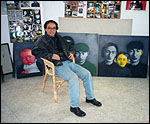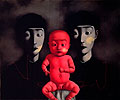|
ZHANG Xiaogang
China b. 1958
Three comrades (from 'Bloodline: The big family'
series) 1994
Oil on canvas
150 x 180cm
Purchased 1996.
Queensland Art Gallery Foundation
Collection: Queensland Art Gallery
Reproduced by permission of the artist
|
 |
The rapid growth of consumerism
in China during the 1990s caused Zhang Xiaogang to begin his
series of paintings 'Bloodline: The big family'. In this series,
the artist comments on a range of social issues related to the
place of the individual within 'modern' Chinese society.
Three comrades is one
of many family groups painted by Zhang Xiaogang in this series.
However, this is not a painting of a standard Chinese family.
Zhang's 'comrades' can be seen as belonging to Chairman Mao's
great 'revolutionary family', where all individuals were brothers
and sisters, irrespective of traditional family ties.
Mao's Cultural Revolution of
1966-77 saw the destruction of many historical icons, including
family photographs. Family photographic portraiture was a
strong tradition in China, and it is the loss of these precious
memories that Zhang Xiaogang addresses in his 'Bloodline:
The big family' series.
Zhang creates a sense of nostalgia
in his compositions by utilising the conventions of the traditional
Chinese photographer. Like his photographic predecessors,
he uses dramatic lighting effects and flat anonymous backgrounds
to idealise his subjects. In this work, the figures are painted
with a smooth pearly finish reminiscent of porcelain, but
are lacking in emotion and turn detached faces to the world.
To the artist, these faces are
representative of a society striving to exist in an increasingly
commodifed and dehumanised world. The comrades hide their
individual personalities and histories behind the facade of
a standardised portrait. Lacking in specific gender, they
appear so similar that we are forced to search for subtle
characteristics - the turn of an eye or a pair of glasses
- that dictate their individuality.
The thin red lines running through
this painting represent the 'big family' ties - the 'bloodlines'
- that connect the three comrades and bind them together as
a group. They are also a link to the past and emphasise that
family relationships have always been important in Chinese
society.
 |
Zhang Xiaogang trained as an oil painter at the Sichuan
Academy of Fine Arts, graduating in 1982. He joined a
group of young avant-garde artists who came to international
prominence during the 1980s. Since that time, he has been
represented in many major international exhibitions, including
'Mao Goes Pop' at Sydney's Museum of Contemporary Art
in 1993, the 1994 Sao Paolo Biennale and the 1995 Venice
Bienniale. Zhang was a joint founder of the Current of
Life painters, and his earlier paintings looked back to
the traditional roots of rural Chinese culture to explore
human values.
|
| Zhang
Xiaogang |
| Other
lines to follow for Zhang Xiaogang |
 |
ZHANG Xioagang
Two comrades with red baby (from 'Bloodline: The
big family' series) 1994
Oil on canvas
150 x 180cm
Collection: The artist
Reproduced by permission of the artist |
'We all live "in a big family".
The first lesson we have to learn is how to protect ourselves
and keep our experiences locked up in an inner chamber away
from the prying eyes of others, while at the same time living
in harmony as a member of this big family. In this sense,
the "family" is a unit for the continuity of life and an idealised
mechanism for procreation. It embodies power, hope, life,
envy, lies, duty and love. The "family" becomes the standard
model and the focus for the contradictions of life experiences.
We interact and depend on each other for support and assurance.'
Zhang Xiogang quoted in Reckoning
with the Past: Contemporary Chinese Painting [exh. cat],
Chang Tsong-Zung (curator), Graeme Murray et al., Fruitmarket
Gallery, Edinburgh, 1996, p.95.
|